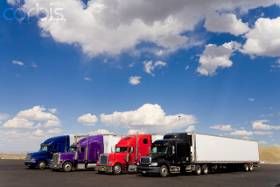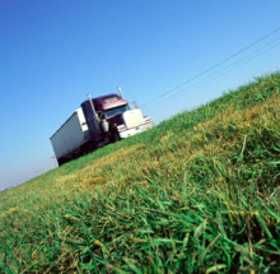Backing To Within The 18inch Stop Area-test Tomorrow-help
Topic 420 | Page 1

Man, Todd...I'll let some of the other guys try to help you with this little problem. As far as I see it, it must come down to gauging your stopping distance. And unless there is a definite line to help you get within that 18 inches...I don't have a clue.... Good Luck on this one. Come On Professional Drivers, Help This Guy Out.

Tongue in cheek. Lol starcar. Thanx.

Guy will probably chime in later, but I'll take a crack at it.
The only drill where we had to stop like that was the alley dock. There were hash marks on the pad leading to the cones that formed the alley. We stopped with our rear drive tires between the fourth and fifth hash mark out from the drivers side front cone. The rear trailer bumper would be square over the middle of that 18" box every time.

It boils down to being able to gage your distance. The best I can tell you, get close & GOAL (Get Out And Look). I know in Missouri you were allowed 2 GOAL for each backing maneuver before they started docking you extra points.
It all comes down to how well you gage distances, & practice is the only cure for that.
Hope this helps.
Ernie

Thanx ernie
It boils down to being able to gage your distance. The best I can tell you, get close & GOAL (Get Out And Look). I know in Missouri you were allowed 2 GOAL for each backing maneuver before they started docking you extra points.
It all comes down to how well you gage distances, & practice is the only cure for that.
Hope this helps.
Ernie
Yeah, the truth is it's nearly impossible to gauge that distance to within 18 inches without getting out to look. If they allow you to, get it within a fair distance safely and then get out to look.
But even after 15 years of driving there's just no way I could look through that mirror along the side of a trailer and accurately gauge from 60+ feet away where the end of that trailer was within 18 inches without shadows to help out. If I had to back into a spot in a truck stop that had another truck behind me, that's what I would do. I would get back a good ways where I knew I was within maybe 5-10 feet of the truck and then get out to look. I would see how much further I had to go and then I would use stones or marks or something in the parking lot alongside the driver's door to judge how far I needed to go. But out there in the real world you wouldn't dare back up to another truck and try to get it that close without getting out to look. You're going to bump into other trucks if you tried doing that regularly, and that's unacceptable of course.

OK here goes something or nothing,ur goin to be looking at the tandems and be gauging by them I see this in truck stops all the time and I tell the drivers get professional BC what they do is park their tandems on the line,in turn that puts the trailer over the line. So what ya do is guage by ur tandems till ur straight in line and getting close then ya watch the icc bumper at the corner yes I said it the back of the trlr,when it looks like its about to go over the line ur bout 18 to 20 inches away I wouldn't back to much further than that,I did this at my test BC we weren't allowed to goal.if we did we falied.
Tandems:
Tandem Axles
A set of axles spaced close together, legally defined as more than 40 and less than 96 inches apart by the USDOT. Drivers tend to refer to the tandem axles on their trailer as just "tandems". You might hear a driver say, "I'm 400 pounds overweight on my tandems", referring to his trailer tandems, not his tractor tandems. Tractor tandems are generally just referred to as "drives" which is short for "drive axles".
Tandem:
Tandem Axles
A set of axles spaced close together, legally defined as more than 40 and less than 96 inches apart by the USDOT. Drivers tend to refer to the tandem axles on their trailer as just "tandems". You might hear a driver say, "I'm 400 pounds overweight on my tandems", referring to his trailer tandems, not his tractor tandems. Tractor tandems are generally just referred to as "drives" which is short for "drive axles".

In my opinion it's really sad that an examiner would fail you for getting out to look. Isn't that what they'd rather you do in real life instead of guessing?
In my opinion it's really sad that an examiner would fail you for getting out to look. Isn't that what they'd rather you do in real life instead of guessing?
You make an excellent point and it's something I've pondered ever since I went to school back in '93.
Here's the problem they face. They need to know that you have solid skills when it comes to handling a vehicle and they need to make sure you're working hard to learn everything to the best of your ability. If you didn't limit the number of pull-ups people were allowed, you let everyone take all the time they needed during the tests to make their maneuvers, and allowed them to get out and look as often as they like, you would allow people to pass the test that had otherwise terrible driving skills.
For instance, say you had to do a 90 degree back into a dock. Even if you have no clue what you're doing you can eventually get the truck into the dock without hitting anything. It might take two or three hours, you might have to get out and look 24 times, and you might do 75 pull-ups, but you'll get it there eventually.
Obviously you wouldn't want people passing the test that didn't have a certain level of competence so you have to come up with some way to test their competency. In order to do that, they'll put limits on the number of pull-ups you get, the number of mistakes you can make, the amount of time you have to execute a maneuver, and things like that. They figure if you can't do the maneuvers within those guidelines then you don't have the competency level they expect.
The downside to that is exactly what you mentioned - you're giving people the idea that pulling up to re-adjust your setup or getting out to look is a mistake or a failure on their part, and obviously that's not the case. I'm 100% certain that a lot of backing accidents happen to rookies because they're under the impression that getting out to look or pulling up too many times is a failure on their part and it's making them look back. So instead of doing it the safest way possible, they take their chances and try to force the truck into a spot even though their setup and positioning is poor.
Honestly, I'm not sure how you can correct that issue. At first you're penalizing someone for doing something because it shows incompetence, but then you're insisting that they do it because it's safer. Unfortunately it's hard to break that initial "penalization mentality" once it's been established, but I'm not sure how you would determine a person's competency otherwise. It's definitely a tough challenge that CDL testing faces.
CDL:
Commercial Driver's License (CDL)
A CDL is required to drive any of the following vehicles:
- Any combination of vehicles with a gross combined weight rating (GCWR) of 26,001 or more pounds, providing the gross vehicle weight rating (GVWR) of the vehicle being towed is in excess of 10,000 pounds.
- Any single vehicle with a GVWR of 26,001 or more pounds, or any such vehicle towing another not in excess of 10,000 pounds.
- Any vehicle, regardless of size, designed to transport 16 or more persons, including the driver.
- Any vehicle required by federal regulations to be placarded while transporting hazardous materials.
HOS:
Hours Of Service
HOS refers to the logbook hours of service regulations.New Reply:
New! Check out our help videos for a better understanding of our forum features

















Preview:








 TT On Facebook
TT On Facebook
I want to sincerely apologize for a past post about a school in Co. Brett was absolutely right. I tried to fast track my way to a class b license. So please forgive me. I will from now on be positive and ask questions that enlighten and help new drivers like my self.
My question is on backing. How do you get a truck in the proper spot to stop within 18 inches? This is the only problem I am having in my training and would covet you expierenced truck drivers. I have tried shadows, markings, and others but just can't seem to get it. Please help. Thank you Todd